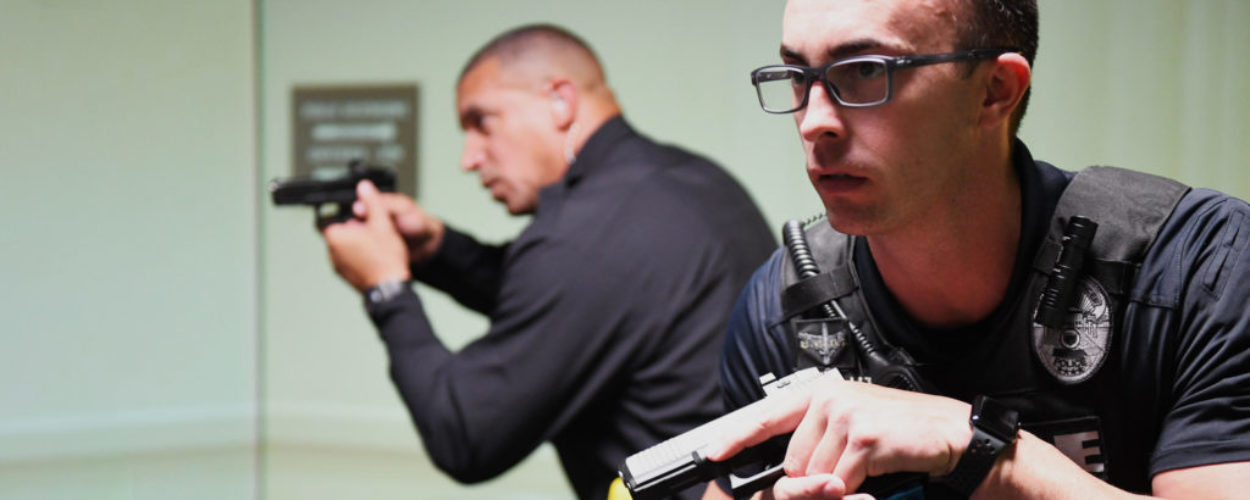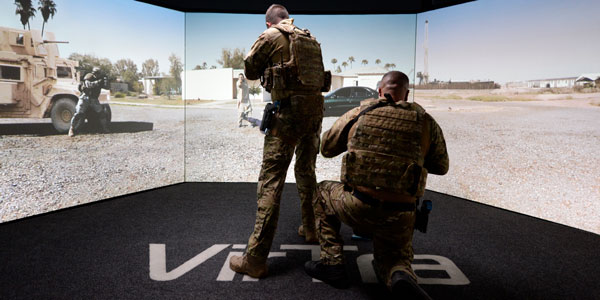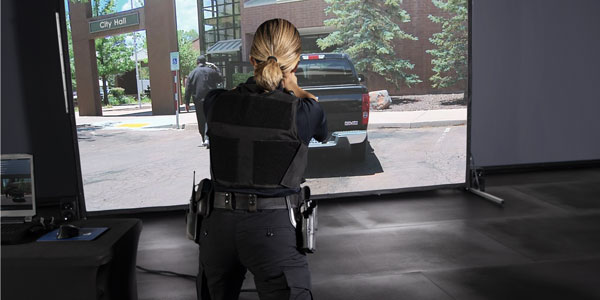
Police and military actions are under a great deal of scrutiny due to social media and a 24-hour news cycle. As such, it has become clear that officers and soldiers can benefit from additional, state-of-the-art training. Judgmental use of force and firearms training simulators provide a realistic, yet safe environment, allowing law enforcement and military to practice responding to various stimuli.
No other training—lectures, role playing, drills or boot camp—come close to the realism provided by VirTra’s extensive line of judgmental use of force and firearms training simulations. Ranging from portable to room-sized, each simulator equips the trainee with the tools to make the best possible force decisions on the streets.
- How Use of Force Simulators Make Law Enforcement & Military Training More Effective
- Creating a 3D Environment in Your Use of Force Simulator
- Why a 300-Degree Law Enforcement Simulator is Crucial for Law Enforcement Training
- How 3D Space and 4D Time Make Simulation Training Even More Immersive
- How Soldiers in the Field Make Better Choices Using a Virtual Simulator
- Improving Defenses against Active Threats/Killers with Virtual Firearms Training
- Stress-Induced Firearms Training Systems Teach Better Judgement in Tough Situations
- Getting the Most out of Virtual Firearms and Use of Force Training with Simulators
- Engaging with Top Military Consultants for Better Engagement and Firearms Training Simulator Results
- Working with the Force Science Institute for More Realistic Firearms Training Systems
How Use of Force Simulators Make Law Enforcement & Military Training More Effective
Trainers often state that teaching officers and soldiers to make rapid, split-second decisions is a huge undertaking. When seconds count, the proper application of force can save lives. Simulators provide an unsurpassed training environment that immerses officers in real world scenarios while allowing for the full spectrum of force- from officer presence to deadly force. With 300 degrees of immersive, high-stress scenarios unfolding around the officer, it challenges them to make calculated decisions on the fly.
Simulators offer the opportunity to train in difficult situations. Officers train to de-escalate a hostile subject or domestic violence encounter. Military alike train to de-escalate to persuade people, insurgents or bad actors to return to the conditions necessary to resolve conflict. Lectures and role playing are good options for training. However, these options cannot offer a critical component: experiential learning. This element is provided by judgmental use of force and firearms training simulators.
Creating a 3D Environment in Your Use of Force Simulator
The more realistic a simulator is, the more effective the training. Departments create 3D environments within their simulators through the addition of props. Believable props, paired with the 300-degree immersive screens and high-tech sound systems, create real-world environments officers and military personnel might experience in the field.
This addition requires attention to detail. For example, rather than utilizing a chair as a mailbox, trainers should build or purchase a realistic-looking mailbox. Instructors must keep props light and portable so they are easy to manage and move for each scenario. The heavier and more difficult a prop is, the less frequently it will be used. Foam, paper, cardboard, and paint provide a good foundation for creating 3D props.
Download the Complete Guide for How Judgmental Use of Force and Firearms Training Simulators Improve Outcomes for Police and Military
Why a 300-Degree Law Enforcement Simulator is Crucial for Law Enforcement Training
Consider the unique benefits a 300-degree firearms training simulator provides. The sheer number of screens immerses the trainees in the scenarios, where the software challenges them with branching options leading to multiple endings. Instead of being taught through lectures or roleplaying, simulator training actually translates into real-world experience through its realistic, seamless video and multi-directional audio. This exposure to stress and high emotions trains the individual to react appropriately in unfamiliar and difficult situations.
After the scenario is completed, instructors can utilize the debriefing capabilities to show trainees their decisions while inside the simulation and review correct and incorrect actions. The best way for an officer to learn is to review their mistakes and discover how to improve.
How 3D Space and 4D Time Make Simulation Training Even More Immersive
As discussed, judgmental use of force and firearms training simulations must be realistic in order to be effective, which makes 3D space and 4D time critical components to simulator training. With standard training situations, departments place cadets and officers into a simulator, watch their performance and offer a debrief before beginning the process with the next trainee. This pattern offers little variation. However, when instructors take advantage of 3D space and 4D time, training becomes far more realistic and effective.
3D space includes props, such as “walls” to teach cover techniques, which could be a painted cardboard cutout. As the scenario plays out, officers can hide behind the wall and take cover while evaluating their options. By moving props as the simulation evolves, it becomes possible to incorporate the 4D time element for added realism.
How Soldiers in the Field Make Better Choices Using a Virtual Simulator
Soldiers put their lives on the line every day. Because of their dedication, VirTra’s goal is to keep them safe while ensuring they receive the best training to make the best decisions. Through judgmental use of force and firearms training simulations, soldiers can experience and learn from a variety of scenarios based on previous soldiers’ experiences.
The instructor’s ability to recreate any situation gives virtual simulations an advantage over other methods of training. Now, instructors control everything from the weather to the visibility of the enemy’s actions, ensuring the soldier’s learning accounts for every possible variant. Following each scenario, the debrief shows the soldier their actions in the simulation, including stance, muzzle discipline and shot placement. Through regular practice and improvement, soldiers can get the upper hand in any situation.
Improving Defenses against Active Threats/Killers with Virtual Firearms Training
Active killer situations are on the rise across the nation, causing law enforcement officers to receive regular training on handling these situations. The V-300 simulator is an excellent alternative to achieving this goal. Its five screens and multi-directional sound provide realistic visuals and unsurpassed audio for scenario immersion. Additional optional training tools include the Threat-Fire®; a device that simulates return fire which enhances training and realism.
Since it is virtually impossible to predict active threat situations, it is crucial for officers to know the best ways to react to, incapacitate and disarm the suspect in order to save lives. Virtual firearms training simulations mimic the real world, making them a powerful tool in any department’s arsenal.
Stress-Induced Firearms Training Systems Teach Better Judgement in Tough Situations
Clinical studies have shown that when officers are in unfamiliar situations and under a great deal of stress, they sometimes make the wrong judgement call. Training in the classroom cannot recreate the level of stress an officer will experience in the field; therefore, they are not taught how to handle the heightened emotion and make the best decisions.
In this regard, firearms training simulations paired with the Threat-Fire® feedback device makes a significant difference. Instructors can place the Threat-Fire® device on the student officer and provide them with an electrical impulse when the officer makes a critical mistake, like improper scanning or not registering threats quickly. This consequence device teaches officers to anticipate behaviors and choices in the field, resulting in better performance and control.
Getting the Most out of Virtual Firearms and Use of Force Training with Simulators
VirTra simulators are designed to provide the best available simulated reality based training for officers and soldiers. These scenarios are more than “shoot don’t shoot”. Instead, the scenarios are incredibly realistic and highly customizable, and include optional features that allow trainers to create and customize scenarios based on their department’s training needs and guidelines.
One example is how trainers can utilize portable simulators to teach balance and stability in the field when officers lack the time needed to get into the proper firing stance. With bigger, more immersive simulations, the addition of props better represents the environment shown on-screen. Through dozens of branching options, trainers can throw “curveballs” in the form of an unexpected action made by the suspect.
Engaging with Top Military Consultants for Better Engagement and Firearms Training Simulator Results
The reason VirTra’s judgmental use of force and firearms training simulators are effective is that they are designed by law enforcement and military experts. VirTra regularly consults with in-house subject matter experts in addition to military and police departments to ensure the software offers the best possible training. VirTra has made a significant effort to create scenarios and tools better suited for military use by hiring Colonel Joe O’Connell, a retired member of the USAR and CEO of JL O’Connell and Associates.
Colonel O’Connell will refer to his years of experience facilitating relationships with military leaders and decision-makers to find the right personnel to help in creating the best training content. With these relationships, VirTra ensures these simulations will provide ample training to police officers and numerous true-to-life scenarios for the military.
Working with the Force Science Institute for More Realistic Firearms Training Systems
VirTra is dedicated to furthering its commitment to law enforcement training through its partnership with the Force Science Institute. Force Science, which researches human behavior as it applies to high-stress situations and the use of force, has partnered with VirTra to create scholarships for officers to partake in Force Science Certification Courses, create unique courses for police departments utilizing their data and to give a joint presentation at the FBI National Academy Associates’ National Conference.
By working together, VirTra and Force Science strive to create powerful firearms training simulations and use of force scenarios based on proven science, case studies and more. Understanding how people react in stressful situations makes it possible to create better training courses to familiarize officers and soldiers.
Law enforcement and military personnel are charged with protecting civilians and keeping the peace. Often, saving lives—including their own—comes down to making a split-second decision. VirTra’s line of judgmental use of force and firearms training simulations is designed to put offices and soldiers in unique, stress-inducing situations that evolve based on the decisions made in the simulation.
Over time, and through regular training, officers and soldiers can learn how to make the quick critical decisions every time, even in high-stress situations. VirTra, along with its partners, is committed to providing the most innovative, state-of-the-art training situations to department and trainers across the world to prepare their forces for the field.
Download the Complete Guide for How Judgmental Use of Force and Firearms Training Simulators Improve Outcomes for Police and Military
Recently Published
Join Our Newsletter









